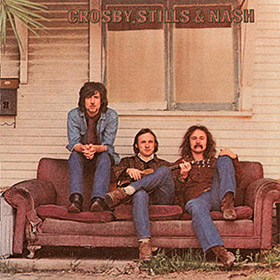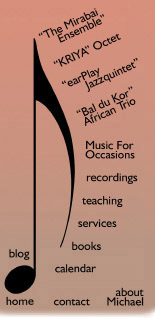|
"You Don't Have To Cry"
"You Don't Have To Cry" is the song (legend has it) that Crosby, Stills,
and
Nash first sang together at Mama Cass's Topanga Canyon house, virtually
electrocuting their hosts. In those early days, they found more
joy in
shocking their friends for the sheer fun of it than playing before thousands
in stadiums.
I, too, was electrocuted at the tender age of 14
when I was shown to my 10th-row center seat
by the group's manager, as a family favor.
I had already been infected five years earlier with the
affliction of band conviction.
Playing in, and writing for, rock bands.
Thankfully, my father saw that the pop music world
was changing fast.
What other teenager could boast of a father who insisted
that his son compose regularly?
And he made darn sure that I experienced first-hand
the artists that were turning the world inside out.
Just who were Crosby, Stills, and Nash? All were considered rebels in their youth — one a cat burglar, another an expert wrestler, the third
a gang member. Alas, only fleeting mischief until real fame caught up
with them. They probably had no idea back then that they would
tour
the world, influence a whole generation of musicians, and be
honored guests at the White House.
How is it possible that men barely in their 20's could create work of
such depth, subtly, and emotional impact? Despite their unassuming
look, "beginners luck" was not at play here — heavy rehearsals and a
clear vision were, though Grace did manage to slip into their guitar
cases. All were experienced enough to be refugees from well-known
bands of their day, nurtured by legendary and generous peers who were themselves reeling from their own bands' respective self-destruction.
When their first record came out, I, like many around me,
was mesmerized—I simply wore out my copy.
I didn't fully understand why it captivated me so,
why it resonated in me in such a singular way.
But I could feel the intimacy that this group was creating
by offering nearly half of its songs as ballads.
And I could feel from my early days of bandleading that
someone on the inside was guiding this project:
The blond gent from Florida who
wrote half of the songs,
played two-thirds of the instruments
("Captain Many Hands" Stills)
and provided the real leadership.
I surely felt the range of their early music passions —
blues
rock
jazz
classical
folk
Latin
as they were my passions, as well.
More American than apple pie,
sweeter than cooked yellow corn,
deeper that Yosemite Falls,
They exemplified what we Americans do best:
Synthesize and Re-invent.
What I heard then in their debut recording was what most teenagers heard — soaring vocal harmonies with perfect blend, compelling melodies with vivid lyrics, and intricate instrumental underpinnings with inspired solos.
What I hear now as I guide my students through their own musical journey is what prompted me to write this ode in the first place. True,
I can describe those qualities in far more detail now than I could four decades ago. But it's really the deep sense of balance and architecture
of the recording as a whole that fascinates me most.
It's ten songs and nearly 43 minutes form one giant arc, not unlike the
St. Matthew Passion by Bach. Not only is the shape of the whole
recording symmetrical, but so too are the sections themselves as they relate to each other.
2 electric band songs (medium & up tempo)
2 acoustic songs (esoteric duet/folk-based trio)
2 electric band songs (medium & slow tempo)
2 acoustic songs (esoteric duet/folk-based trio)
2 electric band songs (medium & medium tempo)
The opening and closing songs are the most complex structurally, bookends, as it were. The opening "Suite: Judy BlueEyes" has the
deepest hybrid of acoustic and electric instrumental colors, while the closing "49 Reasons" uses a constant alternation of triple and duple
meter sections. Even the song midway through the recording "Wooden Ships" has a major change in rhythmic feel. This is real balance as deep
as you'll find in any pop music from the last half century.
Crosby, Stills, and Nash's debut recording felt like it was
created by musicians who could clearly see the horizon
without a care for who else could see it.
Crosby, Stills, Nash and Young's debut recording felt like it was
created by musicians who could clearly see the horizon
and knew that the whole world was waiting
for their impression of it.
Sometimes we can only clarify what makes something truly magical by seeing something that is almost magical. Such is the case with the
follow-up Crosby, Stills, Nash and Young release. There are some stellar moments here to be sure, including the bold transformation of Joni Mitchell's dreamy ballad "Woodstock" into an up-tempo rock anthem.
No expense was spared: over 800 hours of studio time, opulent arrangements, great guest players, and lavish packaging. At last, the
group achieved one of their primary goals — to capture the feeling of
their live performances.
The year that the CSNY LP came out
I was still in high school,
watching the nightly news as the country was seething,
hotter than at any time in our history,
save the Civil War.
And that's what it was at my home,
a civil war...
My sister eventually left home
to live at a commune far, far away,
my father, paralyzed with anger and disappointment,
my mother, studying Swedish anticipating a move
to a less hostile country,
I, deepening my affliction of band conviction.
People were arguing everywhere:
in classrooms,
at band practices,
in checkout lines.
But the music rang out everywhere...
What happened in that intervening year between these two recordings?
Imagine taking an elevator from the ground floor to the 82nd at warp speed. All the fame (and groupies), the "awesome drugs", and huge expectations from fans and critics alike, took its toll. So did the simultaneous collapse of each players' romantic relationships, and the inevitable discovery of everyone's personality flaws. (This last dynamic would plague the band throughout its rocky, and still continually
evolving career).
One of the inevitable by-products of touring is that a band's repertoire becomes very coherent. For example, in the jazz world pieces tend to get looser, while in the pop domain songs often become tighter, with
a palpable in-your-face energy.
It's like a great restaurant that expands and loses
some of its subtlety (or portion size),
a beautiful woman who uses too much makeup,
or a great band that is over amplified.
Everybody tells you that it's even better,
but you just end up scratching your head...
In the end, it comes down to the subject matter of each song, the clarity
of that vision, and whether the artist has created a sense of three-
dimensionality in their performance. Clearly the album as a whole is
very strong, with some exceptional songs such as the title track and "Teach Your Children". I found, though, CSNY's Deja Vu recording
to lack the same compelling storytelling and fundamental sense of
mystery as their earlier CSN release. Hence, it was not surprising to
learn that the group recorded the majority of their tracks in isolation rather than as a group like the CSN project.
As I approach the end of this ode,
I am reminded that analysis is
never an end unto itself.
It must always be in service to the Great River
of artistic experience,
like all of those musicians who enriched the lives of
Crosby, Stills, and Nash.
I am now looking at my new child—
spunky and glistening,
a reconstructed Latin arrangement of Graham Nash's
"Lady Of The Island"
that was born just after beginning this ode.
(March 2010)

back
©2010,
Michael Smolens
|


